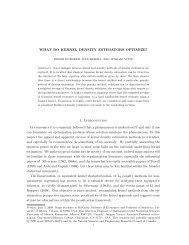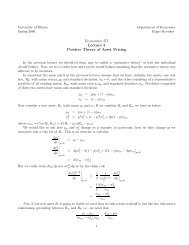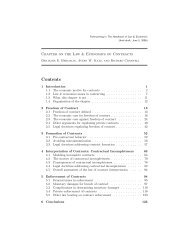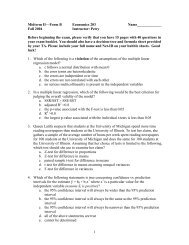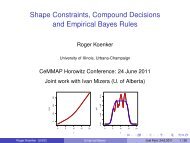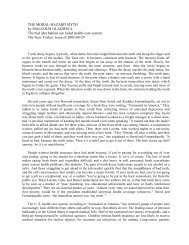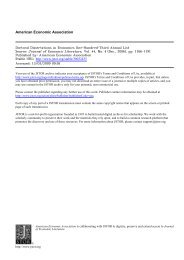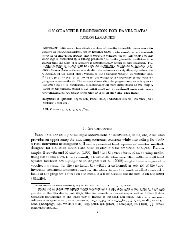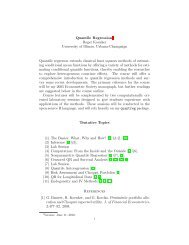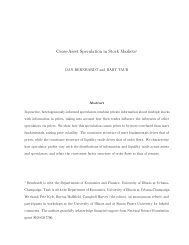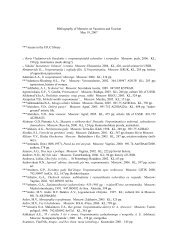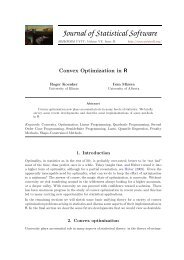1. Introduction - Econometrics at Illinois - University of Illinois at ...
1. Introduction - Econometrics at Illinois - University of Illinois at ...
1. Introduction - Econometrics at Illinois - University of Illinois at ...
Create successful ePaper yourself
Turn your PDF publications into a flip-book with our unique Google optimized e-Paper software.
Roger Koenker and Zhijie Xiao 3the liter<strong>at</strong>ure on condence bands for QQ-plots, e.g. Nair (1982). But the principaldierences emerge from the regression specic<strong>at</strong>ion <strong>of</strong> the conditional quantile functions.In particular, we introduce tests <strong>of</strong> the classical regression specic<strong>at</strong>ions th<strong>at</strong>the covari<strong>at</strong>es aect only the loc<strong>at</strong>ion, or the loc<strong>at</strong>ion and scale, <strong>of</strong> the conditionaldistribution <strong>of</strong> the response variable without requiring a parametric specic<strong>at</strong>ion <strong>of</strong>the innov<strong>at</strong>ion distribution.An altern<strong>at</strong>ive general approach to tests based on empirical processes with estim<strong>at</strong>edparameters entails resampling the test st<strong>at</strong>istic under conditions consistentwith the null hypothesis to obtain critical values. The origins <strong>of</strong> this approach maybe traced to Bickel (1969). Romano (1988) describes implement<strong>at</strong>ions for a variety<strong>of</strong> problems. Andrews (1997) introduces a conditional Kolmogorov-Smirnov test formodel specic<strong>at</strong>ion in parametric settings and uses resampling to obtain critical values,and Abadie (2000) develops rel<strong>at</strong>ed methods for investig<strong>at</strong>ing tre<strong>at</strong>ment eectsin the two sample setting. We hope to explore this approach to quantile regressioninference in subsequent work.The remainder <strong>of</strong> the paper is organized as follows. In the next section, we introducea general paradigm for quantile regression inference focusing initially on thecanonical two-sample tre<strong>at</strong>ment-control model. In Section 3, we briey introduceKhmaladze's approach to handling empirical processes with estim<strong>at</strong>ed nuisance parameters.Section 4 extends this approach to general problems <strong>of</strong> inference basedon the quantile regression process. Section 5 tre<strong>at</strong>s some practical problems <strong>of</strong> implementingthe tests. Section 6 describes an empirical applic<strong>at</strong>ion to the analysis <strong>of</strong>unemployment dur<strong>at</strong>ions. Section 7 contains some concluding remarks.2. The Inference ParadigmTo motiv<strong>at</strong>e our approach it is helpful to begin by reconsidering the classical twosampletre<strong>at</strong>ment-control problem. In the simplest possible setting we can imaginea random sample <strong>of</strong> size, n, drawn from a homogeneous popul<strong>at</strong>ion and randomizedinto n 1 tre<strong>at</strong>ment observ<strong>at</strong>ions, and n 0 control observ<strong>at</strong>ions. We observe a responsevariable, Y i , and are interested in evalu<strong>at</strong>ing the eect <strong>of</strong> the tre<strong>at</strong>ment on this response.In a typical clinical trial applic<strong>at</strong>ion, for example, the tre<strong>at</strong>mentwould be some form<strong>of</strong> medical procedure, and Y i ,might be log survival time. In our applic<strong>at</strong>ion discussedin Section 6, the tre<strong>at</strong>ment is an oer <strong>of</strong> a cash bonus for early exit from a spell <strong>of</strong>unemployment, and Y i is the logarithm <strong>of</strong> individual i's unemployment dur<strong>at</strong>ion. Inthe rst instance we might be s<strong>at</strong>ised to know simply the mean tre<strong>at</strong>ment eect, th<strong>at</strong>is, the dierence in means for the two groups. This we could evalu<strong>at</strong>e by \runningthe regression" <strong>of</strong> the observed y i 's on an indic<strong>at</strong>or variable: x i = 1, if subject iwas tre<strong>at</strong>ed, x i = 0, if subject i was a control. Of course this regression wouldpresume, implicitly, th<strong>at</strong> the variability <strong>of</strong>thetwo subsamples was the same; thisobserv<strong>at</strong>ion opens the door to the possibility th<strong>at</strong> the tre<strong>at</strong>ment alters other fe<strong>at</strong>ures



